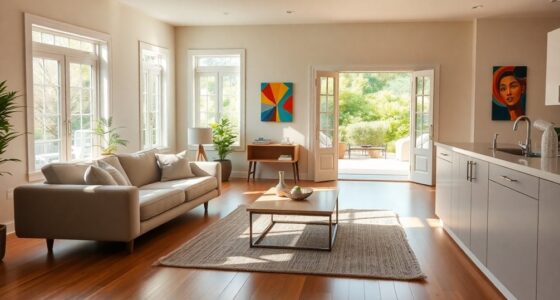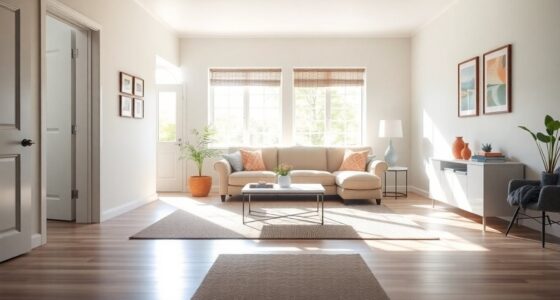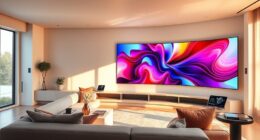When designing a home for low vision, you should incorporate high-contrast colors, bright lighting, and tactile cues to improve safety and navigation. Use contrasting wall and floor colors, textured surfaces on handles or controls, and strategic lighting near key areas. Smart devices with voice control, motion sensors, and visual aids can further enhance independence. If you continue exploring, you’ll discover more practical ideas to create a safe, accessible living space tailored to your needs.
Key Takeaways
- Incorporate high-contrast color schemes for walls, floors, and furniture to improve object visibility.
- Install bright, evenly distributed lighting with adjustable options to reduce shadows and enhance clarity.
- Use tactile markings and textured surfaces on controls, handles, and signage for easy identification.
- Design clear pathways free of clutter and add contrasting edge strips on stairs for safety.
- Integrate assistive technologies like voice-activated systems and magnification devices to support independence.

Have you ever considered how design can accommodate those with low vision? When creating a home that’s accessible, incorporating assistive technology is essential. These tools are designed to help people with visual impairments navigate safely and independently. For example, voice-activated lighting systems or smart home devices can be controlled without needing to see small buttons or switches. Magnification apps or screen readers can also make daily tasks more manageable. But technology alone isn’t enough; thoughtful design choices play a *crucial* role in making a home truly accessible.
One of the most effective strategies is emphasizing color contrast. High contrast between walls, floors, and furniture makes it easier for someone with low vision to distinguish different surfaces and objects. For example, painting door frames and baseboards in a darker shade than the walls creates a clear visual boundary. Using contrasting colors on stair edges, such as a bright yellow or white strip on dark treads, can prevent trips and falls. When selecting furniture, opt for pieces with distinct colors or patterns that stand out against the background, aiding in spatial awareness. These simple adjustments *significantly* improve safety and independence.
Lighting also plays a *vital* role. Bright, well-distributed lighting reduces shadows and enhances visibility. Avoid overly harsh or flickering lights that can cause discomfort. Instead, incorporate adjustable lighting options, like dimmers or task lights, so you can tailor brightness levels as needed. Positioning lights strategically near key areas—such as the kitchen counters, bathroom, and hallways—ensures critical pathways are clearly visible. Additionally, installing motion sensors can alert you to movement, which is especially helpful in unfamiliar or dimly lit spaces. Proper lighting and contrast are critical components of accessible design. Moreover, understanding the importance of interior design principles can help create spaces that are both functional and aesthetically pleasing for those with low vision. Incorporating adaptive technology can further enhance independence and safety in daily routines. Recognizing visual impairments in home design encourages more inclusive and adaptable environments. Creating accessible features tailored to low vision needs can greatly improve daily comfort and confidence.
When designing for low vision, consider tactile features as well. Textured surfaces or raised markings on important items like thermostats, appliance controls, and door handles help identify objects through touch. Clear, large signage with high-contrast lettering can guide you through your home effortlessly. Also, keeping pathways free of clutter and obstacles is *crucial* to prevent accidents.
Ultimately, integrating assistive technology and choosing high-contrast color schemes creates an environment that promotes safety and independence. These design elements work together to make your home more navigable for someone with low vision. It’s about crafting a space that’s not only functional but also welcoming and empowering. With these thoughtful modifications, you can *significantly* enhance quality of life, allowing anyone with low vision to move confidently and comfortably within their home.
Frequently Asked Questions
How Can I Improve Outdoor Navigation for Low Vision?
To improve outdoor navigation for low vision, focus on clear wayfinding signage with high contrast and large print, making it easier to identify directions. Incorporate tactile paving along pathways to provide tactile cues and guide users safely through outdoor spaces. These features help you stay oriented and move confidently, reducing the risk of accidents. Consistent, well-placed signage and tactile paving are essential for enhancing safety and independence outdoors.
What Are the Best Low Vision-Friendly Kitchen Modifications?
Did you know that nearly 80% of accidents in the kitchen involve falls or cuts? To make your kitchen safer, add contrast countertops to help you distinguish surfaces easily. Use tactile labels on appliances and cabinets for quick identification. Bright, non-glare lighting also enhances visibility. These modifications help you navigate confidently and reduce hazards, making your kitchen more accessible and safer for low vision needs.
How Do I Select Tactile or Audio Home Security Systems?
When choosing a security system, prioritize tactile signage and audio alerts to guarantee easy recognition and operation. Look for systems with clear, raised labels and distinct sounds that alert you to activity or issues. You should test these features beforehand, ensuring they’re loud enough and easily distinguishable. This way, you stay informed and secure, regardless of your visual ability, making your home safer and more accessible.
Can Smart Home Technology Assist Those With Low Vision?
Smart home technology can considerably assist you with low vision. Voice assistants let you control devices hands-free, making tasks easier and safer. Automated lighting adjusts brightness instantly, reducing eye strain and improving visibility. These features simplify daily routines, enhance independence, and create a more comfortable living environment. By integrating voice-controlled systems and automated lighting, you can navigate your home more confidently and efficiently, tailored to your specific needs.
What Are Cost-Effective Solutions for Low Vision Home Adaptations?
Thinking outside the box can save you money. You can start by installing affordable lighting that brightens key areas and enhances contrast, making navigation easier. Use contrasting colors on walls, furniture, and floors to provide visual cues. Simple modifications like tactile labels or textured doorknobs also make a difference. These cost-effective solutions help you create a safer, more accessible home without breaking the bank.
Conclusion
By incorporating thoughtful features like high-contrast colors, ample lighting, and tactile cues, you create a home that’s truly inclusive for those with low vision. As you build this accessible haven, remember that even in these modern times, a warm, welcoming space echoes the comfort of a bygone era. Your efforts help guarantee everyone can navigate their home with independence and dignity—turning your humble abode into a sanctuary of hope and safety.









